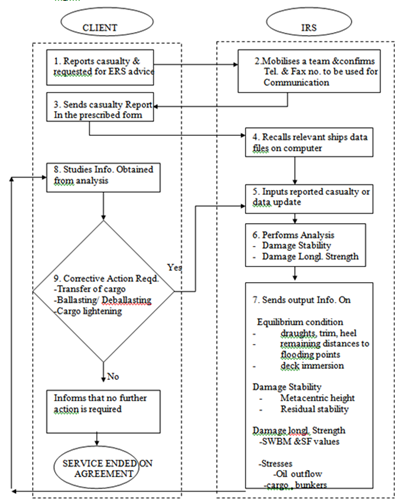Ship Emergency Response
The Emergency Response Service (ERS) is aimed at providing a speedy assessment of the stability and longitudinal strength of a damaged ship in an emergency event. All salient data of the vessels relating to the main hull and its components is stored in computer system along with the loading guidance and strength data. In the event of an emergency, the assessment is carried out using the stored data and details of the damage sustained by means of in- house computer software.
ERS is intended to provide such information round the clock, so that the ship’s crew and management can evaluate the various options available in an emergency before making a decision.
Why Choose IRClass?
The Ship Emergency Response Service from IRClass goes beyond the IACS’ recommendation and is continuously evolving to better meet our clients’ needs. Our arrangements and procedures also meets the industry guidelines. All vessels, irrespective of whether it is classed with us, can enroll on our Ships Emergency Response Service. Reasons to choose us include:
- We use powerful software such as NAPA
- We have the technical expertise with relevant experience
- We can co-ordinate with regulatory authorities who can extend necessary help to your vessel regardless of your ship position
- To Indian owners, we are able to offer an added regional communication advantage of being able to communicate in Hindi
- We are affordable
How does the process work?
As a ship registers for the ERS with us, all her basic data pertaining to trim, stability and longitudinal strength in damaged conditions are uploaded into our electronic database at our Head Office at Powai, Mumbai.
Subsequently, during the establishment phase, this data is validated and is run against a few scenarios to confirm the correctness of the software and data. This part of the establishment phase report is also attached to the ERS Manual as Annexure-II. It is recommended that ship’s deck officers refer to this part frequently, as a real life casualty may have already been covered in the examples considered. It is likely that the intact condition considered in the example may differ from the real life condition, but it still would provide some useful information.
In case of an emergency, based on the information provided by the vessel’s Master, IRClass can analyze the ship’s condition using the stored stability information and suggest various options and course of action. The procedure is graphically represented in the flow chart given in Fig. 1 below. The IRClass team will remain available throughout the incident for any re-analysis based on updates to the casualty report form or proposed alternatives and the service shall be ended in agreement with the client.
Figure 1: Fig. 1. WORK FLOW FOR ERS

The ERS consists of two phases:
Establishment of a ship under ERS scheme (Phase 1):
- Establishment of ship's particulars on computer database on receipt of a request from the ship owner.
- Preparation of the ERS Manual for the ship and handing over the ERS manual to the client.
Emergency Event Response (Phase 2)
In the event that an emergency event is triggered, an examination of the ship's stability and longitudinal strength in the damaged condition will be carried out on base on the damage report from the client.
Time frame for ERS would be dependent on how critical the event is based on the request of the client and prompt availability of casualty information. However, the time frame would not exceed 6 (six) hours unless intimated to the clients accordingly







